Page 1877 of 4264
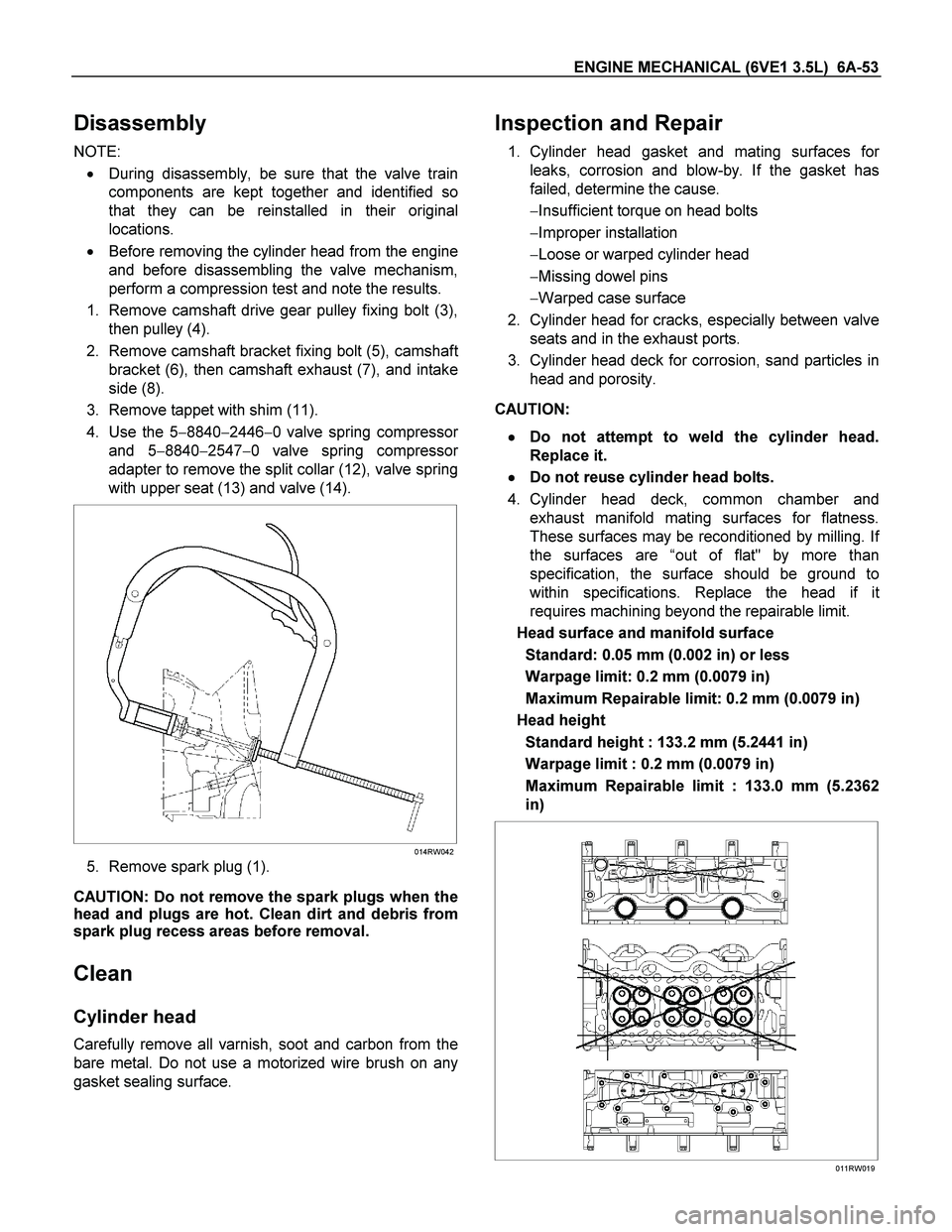
ENGINE MECHANICAL (6VE1 3.5L) 6A-53
Disassembly
NOTE:
� During disassembly, be sure that the valve train
components are kept together and identified so
that they can be reinstalled in their original
locations.
� Before removing the cylinder head from the engine
and before disassembling the valve mechanism,
perform a compression test and note the results.
1. Remove camshaft drive gear pulley fixing bolt (3),
then pulley (4).
2. Remove camshaft bracket fixing bolt (5), camshaf
t
bracket (6), then camshaft exhaust (7), and intake
side (8).
3. Remove tappet with shim (11).
4. Use the 5�8840�2446�0 valve spring compresso
r
and 5�8840�2547�0 valve spring compressor
adapter to remove the split collar (12), valve spring
with upper seat (13) and valve (14).
014RW042
5. Remove spark plug (1).
CAUTION: Do not remove the spark plugs when the
head and plugs are hot. Clean dirt and debris from
spark plug recess areas before removal.
Clean
Cylinder head
Carefully remove all varnish, soot and carbon from the
bare metal. Do not use a motorized wire brush on any
gasket sealing surface.
Inspection and Repair
1. Cylinder head gasket and mating surfaces for
leaks, corrosion and blow-by. If the gasket has
failed, determine the cause.
�Insufficient torque on head bolts
�Improper installation
�Loose or warped cylinder head
�Missing dowel pins
�Warped case surface
2. Cylinder head for cracks, especially between valve
seats and in the exhaust ports.
3. Cylinder head deck for corrosion, sand particles in
head and porosity.
CAUTION:
�
�� � Do not attempt to weld the cylinder head.
Replace it.
�
�� � Do not reuse cylinder head bolts.
4. Cylinder head deck, common chamber and
exhaust manifold mating surfaces for flatness.
These surfaces may be reconditioned by milling. I
f
the surfaces are “out of flat" by more than
specification, the surface should be ground to
within specifications. Replace the head if i
t
requires machining beyond the repairable limit.
Head surface and manifold surface
Standard: 0.05 mm (0.002 in) or less
Warpage limit: 0.2 mm (0.0079 in)
Maximum Repairable limit: 0.2 mm (0.0079 in)
Head height
Standard height : 133.2 mm (5.2441 in)
Warpage limit : 0.2 mm (0.0079 in)
Maximum Repairable limit : 133.0 mm (5.2362
in)
011RW019
Page 1881 of 4264
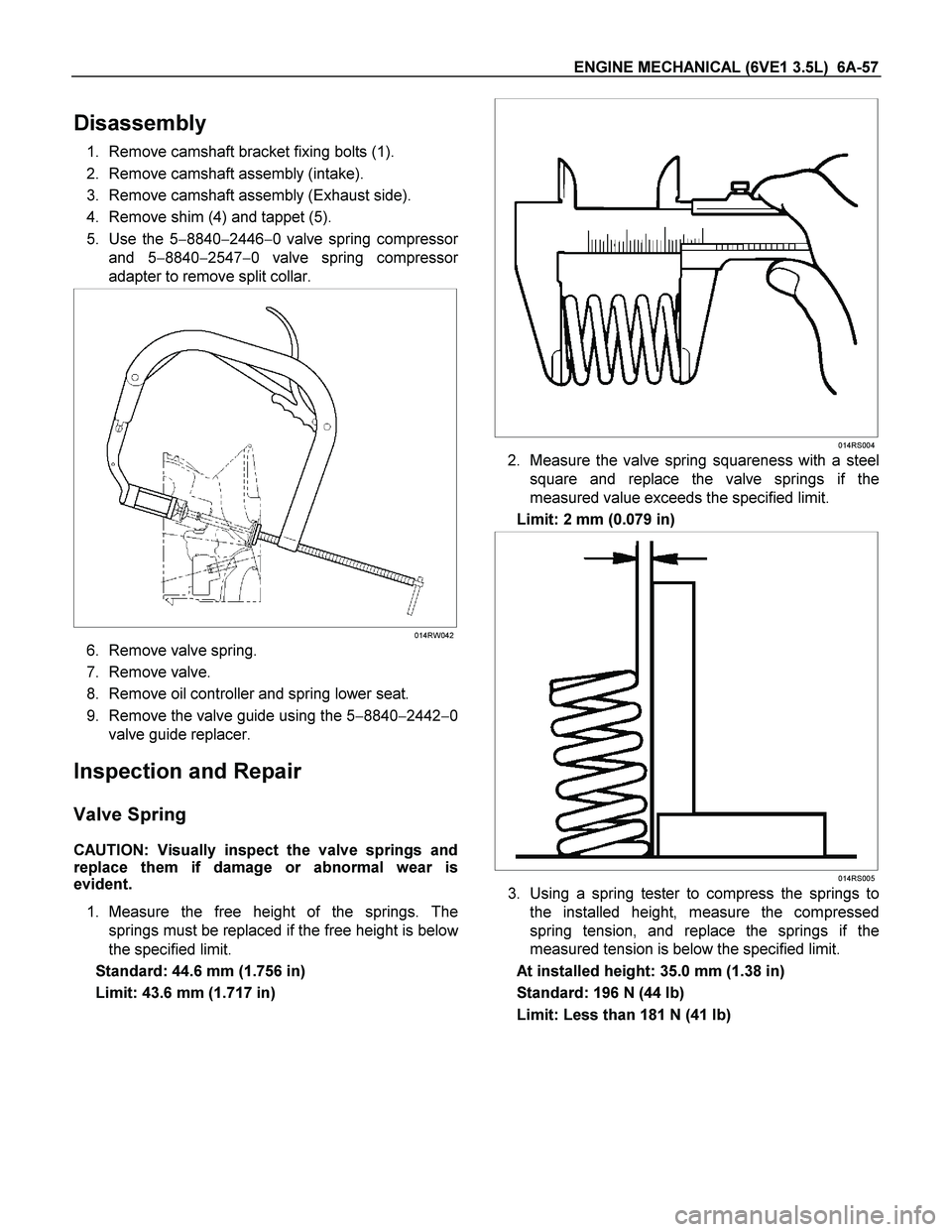
ENGINE MECHANICAL (6VE1 3.5L) 6A-57
Disassembly
1. Remove camshaft bracket fixing bolts (1).
2. Remove camshaft assembly (intake).
3. Remove camshaft assembly (Exhaust side).
4. Remove shim (4) and tappet (5).
5. Use the 5�8840�2446�0 valve spring compresso
r
and 5�8840�2547�0 valve spring compressor
adapter to remove split collar.
014RW042
6. Remove valve spring.
7. Remove valve.
8. Remove oil controller and spring lower seat.
9. Remove the valve guide using the 5�8840�2442�0
valve guide replacer.
Inspection and Repair
Valve Spring
CAUTION: Visually inspect the valve springs and
replace them if damage or abnormal wear is
evident.
1. Measure the free height of the springs. The
springs must be replaced if the free height is belo
w
the specified limit.
Standard: 44.6 mm (1.756 in)
Limit: 43.6 mm (1.717 in)
014RS004
2. Measure the valve spring squareness with a steel
square and replace the valve springs if the
measured value exceeds the specified limit.
Limit: 2 mm (0.079 in)
014RS005
3. Using a spring tester to compress the springs to
the installed height, measure the compressed
spring tension, and replace the springs if the
measured tension is below the specified limit.
At installed height: 35.0 mm (1.38 in)
Standard: 196 N (44 lb)
Limit: Less than 181 N (41 lb)
Page 1884 of 4264
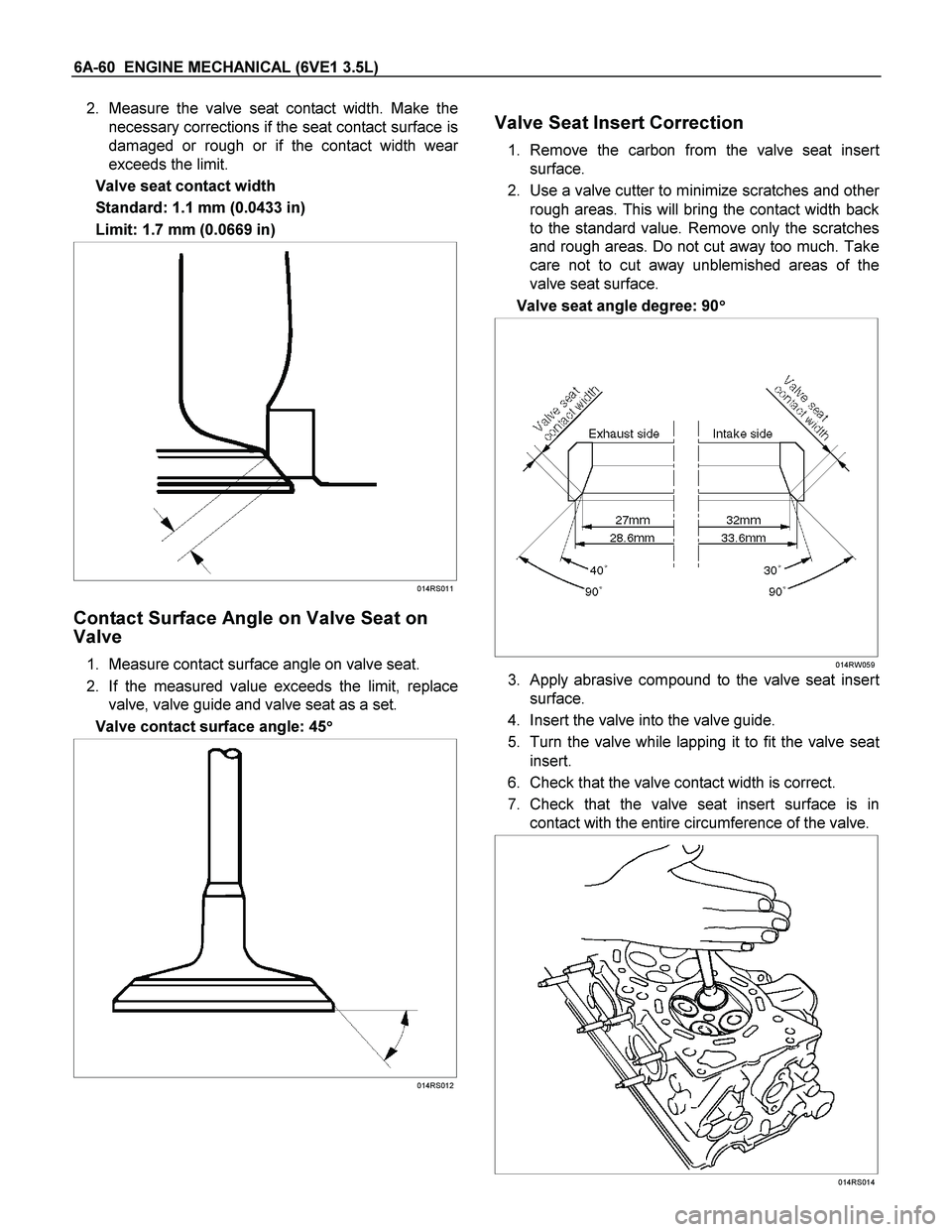
6A-60 ENGINE MECHANICAL (6VE1 3.5L)
2. Measure the valve seat contact width. Make the
necessary corrections if the seat contact surface is
damaged or rough or if the contact width wea
r
exceeds the limit.
Valve seat contact width
Standard: 1.1 mm (0.0433 in)
Limit: 1.7 mm (0.0669 in)
014RS011
Contact Surface Angle on Valve Seat on
Valve
1. Measure contact surface angle on valve seat.
2. If the measured value exceeds the limit, replace
valve, valve guide and valve seat as a set.
Valve contact surface angle: 45�
�� �
014RS012
Valve Seat Insert Correction
1. Remove the carbon from the valve seat insert
surface.
2. Use a valve cutter to minimize scratches and othe
r
rough areas. This will bring the contact width back
to the standard value. Remove only the scratches
and rough areas. Do not cut away too much. Take
care not to cut away unblemished areas of the
valve seat surface.
Valve seat angle degree: 90�
�� �
014RW059
3. Apply abrasive compound to the valve seat insert
surface.
4. Insert the valve into the valve guide.
5. Turn the valve while lapping it to fit the valve sea
t
insert.
6. Check that the valve contact width is correct.
7. Check that the valve seat insert surface is in
contact with the entire circumference of the valve.
014RS014
Page 1886 of 4264
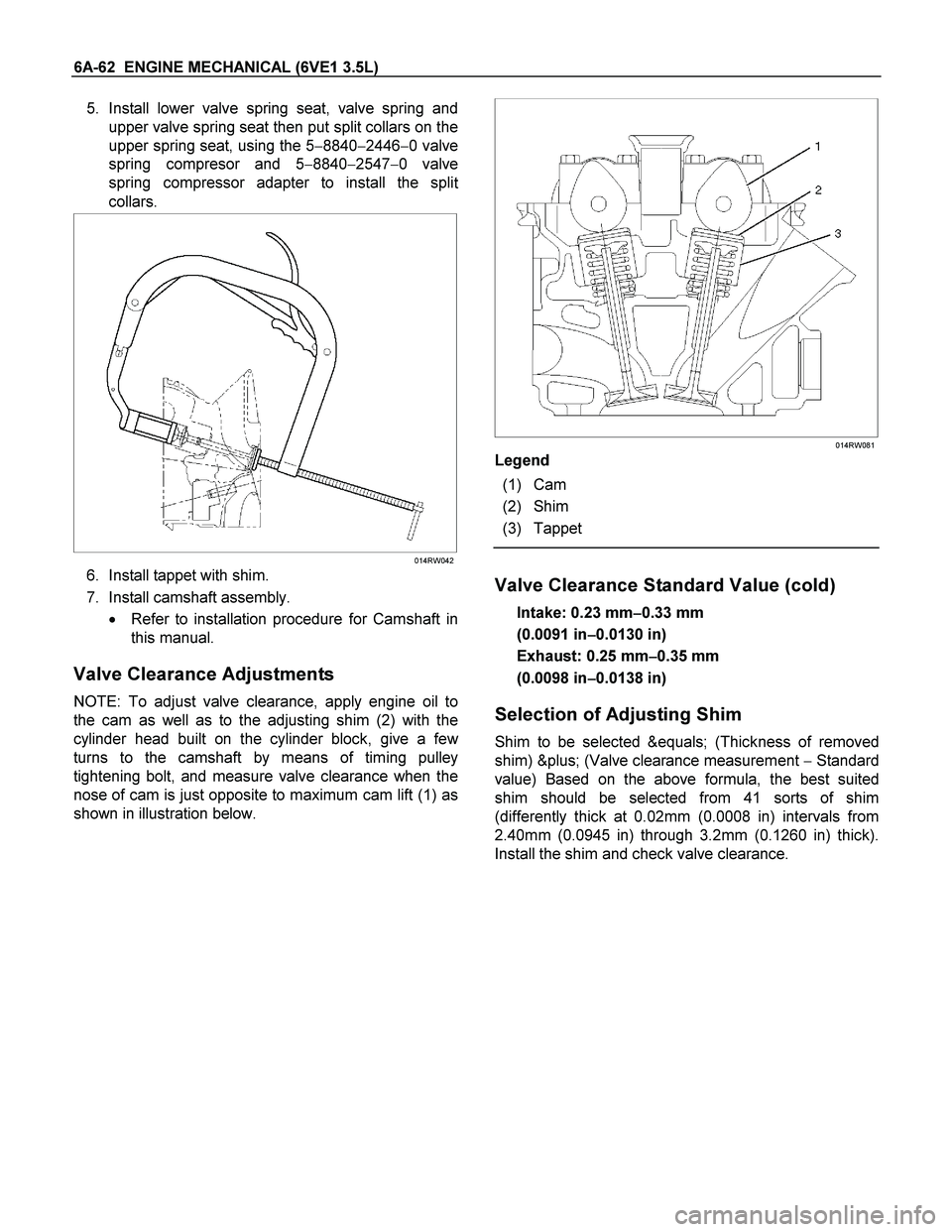
6A-62 ENGINE MECHANICAL (6VE1 3.5L)
5. Install lower valve spring seat, valve spring and
upper valve spring seat then put split collars on the
upper spring seat, using the 5�8840�2446�0 valve
spring compresor and 5�8840�2547�0 valve
spring compressor adapter to install the spli
t
collars.
014RW042
6. Install tappet with shim.
7. Install camshaft assembly.
� Refer to installation procedure for Camshaft in
this manual.
Valve Clearance Adjustments
NOTE: To adjust valve clearance, apply engine oil to
the cam as well as to the adjusting shim (2) with the
cylinder head built on the cylinder block, give a fe
w
turns to the camshaft by means of timing pulley
tightening bolt, and measure valve clearance when the
nose of cam is just opposite to maximum cam lift (1) as
shown in illustration below.
014RW081
Legend
(1) Cam
(2) Shim
(3) Tappet
Valve Clearance Standard Value (cold)
Intake: 0.23 mm�
�� �0.33 mm
(0.0091 in�
�� �0.0130 in)
Exhaust: 0.25 mm�
�� �0.35 mm
(0.0098 in�
�� �0.0138 in)
Selection of Adjusting Shim
Shim to be selected = (Thickness of removed
shim) + (Valve clearance measurement �Standard
value) Based on the above formula, the best suited
shim should be selected from 41 sorts of shim
(differently thick at 0.02mm (0.0008 in) intervals from
2.40mm (0.0945 in) through 3.2mm (0.1260 in) thick).
Install the shim and check valve clearance.
Page 1888 of 4264
6A-64 ENGINE MECHANICAL (6VE1 3.5L)
Camshaft
Camshaft and Associated Parts
014RW040
Legend
(1) Camshaft Bracket Fixing Bolt
(2) Camshaft Bracket
(3) Camshaft Assembly Intake
(4) Camshaft Assembly Exhaust
(5) Pulley Fixing Bolt
(6) Camshaft Drive Gear Pulley
(7) Retainer Fixing Bolt
(8) Retainer
(9) Camshaft Drive Gear
(10) Oil Seal
Disassembly
1. Remove fixing bolt (5) for camshaft drive gear
pulley using 5�8840�2447&�ndash;0 universal
holder.
Page 1889 of 4264
ENGINE MECHANICAL (6VE1 3.5L) 6A-65
014RW060
2. Remove twenty fixing bolts from inlet and exhaust
camshaft bracket on one side bank, then camshaft
brackets (2).
014RW027
3. Remove camshaft assembly (3), (4).
4. Remove three fixing bolts (7) from camshaft drive
gear retainer (8), then camshaft drive gea
r
assembly.
Inspection and Repair
1. Use a micrometer to measure the cam lobe height
and uneven wear. Replace the camshaft if eithe
r
the lobe height or the uneven wear exceeds the
specified limit.
Lobe height: 44.709 mm (1.7602 in)
Uneven wear: 0.05 mm (0.0020 in)
014RW043
2. Use a micrometer to measure the diameter and
the uneven wear of the camshaft journals.
Replace the camshaft if the diameter or the
uneven wear exceeds the specified limit.
Journal Diameter
Standard: 25.972 mm�
�� �25.993 mm (1.0225
in�
�� �1.0233 in)
Limit: 25.8 mm (1.0157 in)
Uneven wear: 0.05 mm (0.0020 in)
014RS023
Page 1895 of 4264
ENGINE MECHANICAL (6VE1 3.5L) 6A-71
Crankshaft
Crankshaft and Associated Parts
013RW009
Legend
(1) Cylinder Head Assembly
(2) Crankcase with Oil Pan
(3) Oil Pipe and O-Ring
(4) Oil Strainer and O-Ring
(5) Oil Pump Assembly
(6) Cylinder Block Side Bolts
(7) Oil Gallery
(8) Piston and Connecting Rod Assembly
(9) Flywheel
(10) Rear Oil Seal Retainer and Oil Seal
(11) Main Bearing Cap
(12) Crankshaft
(13) Main Bearing Cap Fixing Bolts
(14) Oil Gallery Fixing Bolts
Disassembly
1. Remove cylinder head assembly (1). Refer to
“Head" in this manual. 2. Remove crankcase with oil pan (2). Refer to “Oil
Pan and Crankcase" in this manual.
CAUTION: Take care not to damage or deform the
sealing flange surface of crankcase.
Page 1896 of 4264
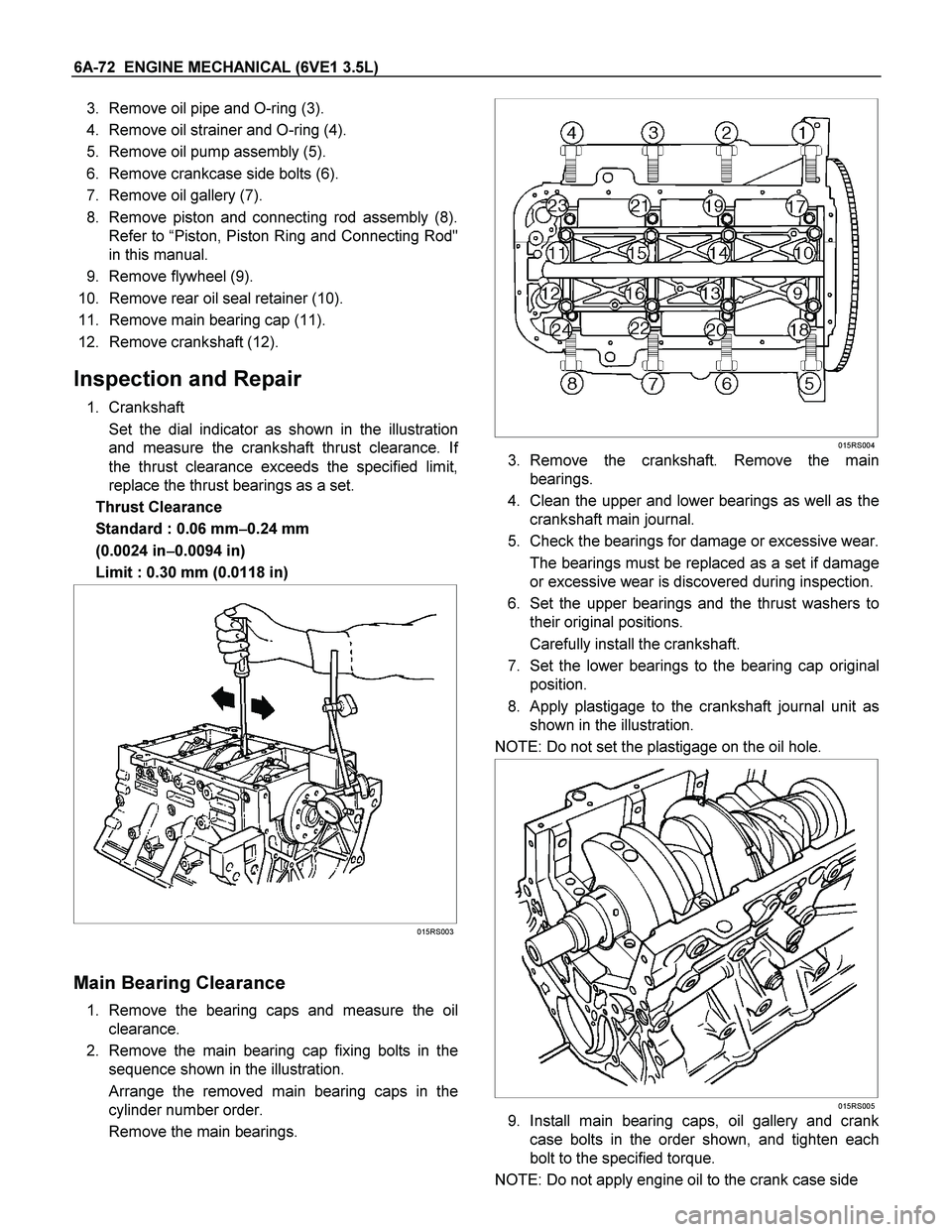
6A-72 ENGINE MECHANICAL (6VE1 3.5L)
3. Remove oil pipe and O-ring (3).
4. Remove oil strainer and O-ring (4).
5. Remove oil pump assembly (5).
6. Remove crankcase side bolts (6).
7. Remove oil gallery (7).
8. Remove piston and connecting rod assembly (8).
Refer to “Piston, Piston Ring and Connecting Rod"
in this manual.
9. Remove flywheel (9).
10. Remove rear oil seal retainer (10).
11. Remove main bearing cap (11).
12. Remove crankshaft (12).
Inspection and Repair
1. Crankshaft
Set the dial indicator as shown in the illustration
and measure the crankshaft thrust clearance. I
f
the thrust clearance exceeds the specified limit,
replace the thrust bearings as a set.
Thrust Clearance
Standard : 0.06 mm�
�� �0.24 mm
(0.0024 in�
�� �0.0094 in)
Limit : 0.30 mm (0.0118 in)
015RS003
Main Bearing Clearance
1. Remove the bearing caps and measure the oil
clearance.
2. Remove the main bearing cap fixing bolts in the
sequence shown in the illustration.
Arrange the removed main bearing caps in the
cylinder number order.
Remove the main bearings.
015RS004
3. Remove the crankshaft. Remove the main
bearings.
4. Clean the upper and lower bearings as well as the
crankshaft main journal.
5. Check the bearings for damage or excessive wear.
The bearings must be replaced as a set if damage
or excessive wear is discovered during inspection.
6. Set the upper bearings and the thrust washers to
their original positions.
Carefully install the crankshaft.
7. Set the lower bearings to the bearing cap original
position.
8.
Apply plastigage to the crankshaft journal unit as
shown in the illustration.
NOTE: Do not set the plastigage on the oil hole.
015RS005
9. Install main bearing caps, oil gallery and crank
case bolts in the order shown, and tighten each
bolt to the specified torque.
NOTE: Do not apply engine oil to the crank case side